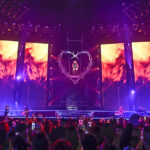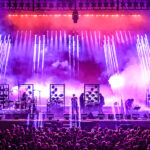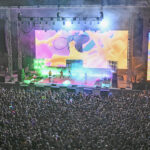Longtime LD Angus MacPhail on the Band’s Latest Trek
The Cure performed another of their marathon more-than-three-hour concert performances to a packed amphitheater of devoted fans, performing both hits and rarities in their ever-evolving set list. There’s no denying the bands influence and originality in a career spanning 40 years. Bringing even more mood and impact to vocalist Robert Smith and the band is lighting designer and director Angus MacPhail, who talked to us about his long association with the band.
“My association with The Cure goes back a long way. I met them while I was lighting Generation X at the Marquee Club as it existed then on Wardour Street in Soho, London with just a few PAR cans dotted around the stage. I began lighting the band then on a regular basis, using a lot of blue and floor lights, which were not, really used much by anyone at the time. As the band’s popularity grew and venues grew larger, we were able to use Genie Towers, quite state-of-the-art for the time.
“Vocalist Robert Smith takes a great deal of interest in the planning of the lighting and content for the shows. Modern tech lets us record everything, either from the Visualizer, or an FOH show cam. So I’m kept on my toes! Using Visualizers is very helpful. Being able to program lighting and media content onto a screen in a small studio with no distractions allows a greater attention to detail. I find that the whole system has improved greatly over recent years.
“Although the basic rules of lighting are still the same as ever, the design and execution these days have so many more possibilities. I now use timecode a great deal. It allows for some quite complex programming that would be quite difficult to do manually.”

MacPhail says he does try and visit at least one lighting expo every year to see what’s new or coming up on the market, as well as looking online.
“This didn’t happen way back when; it was word-of-mouth, or coming across a fixture in a lighting warehouse and playing with it. I think I’m more open to different influences than I would have been years back, so I’ve changed there, but my overall perception has been fairly consistent, I imagine.”

The band has approximately 115 songs programmed, along with another 25 on file.
“We must have 6,000 or more cues altogether, and the number keeps going up! …On the road, we tweak as we go, but all the songs are programmed initially in pre-production. To start with, I will come up with a design, which evolves into a plan alongside discussions with Robert (Smith), co-production designers Ben Hornshaw and Dan Large and, finally, Phil Broad, our production manager.
“During pre-production, as a rule, I will listen to the songs and read the lyrics, mark out verses, the chorus, etc. Also, I will take into account any notes that Robert has written in relation to the song in question. When we have a time coded version of the song that is compatible with how the band will play live, we will punch into the grandMA2 all the major, and some minor cue points into the area of timecode we have earmarked for this or that particular song.
“Ben is responsible for the programming of the grandMA2 lighting desk and all things related, including any fixes that we have to make when the show is running. However, I tend to run all the song fade ins and outs, which are generally but not always run manually, especially on the song fade outs.”
Before a tour, MacPhail will present PRG lighting and Ben Hornshaw with a list of fixture choices he likes, with Hornshaw also making suggestions. Both MacPhail and Hornshaw are nearly always in total agreement.
“I will then give Ben a list of colors, chases etc., to program into the console, and thus we build the lighting for the song. Dan Large is responsible for the five rear video screens along with the video team, and all content and cameras onstage and FOH. A big shout out goes to Stefaan Michaels of PRG/Nocturne. He really put a lot of effort into giving us what we wanted and needed in video and camera world.
“With video content, Dan and I will look at intensity, color tone, etc., and tweak when needed. Some occasions we go through a series of images based on something Robert has requested, and when we’ve agreed, Dan will put it all together and load it so it can be triggered by the time code.
“Initially, a decision was made to use only PRG stock, or items that were on their ‘buy’ list. Which we achieved. Luckily, PRG have quite a diverse stock! The reason for this was part economic and part practical — we wanted the same fixtures everywhere as possible, and PRG, being an international company fitted the bill here. Reliability, budget, and so on, are all covered. Also, Jon Cadbury, PRG’s account manager, did all he could to advise and help. I’m truly grateful for all his help.”

MacPhail had used the PRG Best Boy Spots and Washes a year previously at the Eventim Apollo and found them powerful and reliable, so using those as the major part of his truss lighting was logical.
“I picked the Mythos after a visit to Clay Paky in Bergamo, Italy courtesy of Philip Norfolk at Ambersphere and saw them still in development. I thought ‘Yes!’ immediately for my list. I like the intensity of the gobo looks and the color.
“Going back to PRG, they have an extensive range of GLPs in stock, which I’d seen at PLASA London. Very impressed by all their GLP stock, which I found extremely reliable. The X4Ls gave some real extra punch on the six rear torms. Also the GLP Impression Bars in the truss were effective, and as a bonus I managed to use the tilt function on a couple of occasions.
“The Ayrton MagicBlades I also viewed at PLASA, and knew right away I’d want them as soon as I saw them. They can be used in conjunction with the video feedback and create some quite unusual lighting effects. They definitely can, and do, go to 11.
“We have a number of fixtures on the floor, and for the downstage, I use the Sharpy Wash. It did what was needed without taking up too much obvious stage space. Likewise, the GLP X4s, which fit nicely under the risers. For the rear floor, I picked Atomic Strobes. I wanted a slightly different strobe to the truss strobes, which are more dynamic. However, I used Solaris Flares in the trusses, which are impressive in color and when FX are needed.”

Darren Butler worked on video content for the show along with Dan Large and MacPhail, all adding to the mix.
“It’s all worked rather well, and one nice piece was the backlit smoky band figures that were filmed by Darren in rehearsals. It looks really dynamic live, I think. Everything about the show was designed to blend together. Ideally, nothing would stand out in isolation, so everything stands out in harmony! Marrying the intensity of the content and the lights is important to me.”
More phtotos by Steve Jennings of The Cure’s 2016 tour:
{gallery}16/08/thecure{/gallery}


